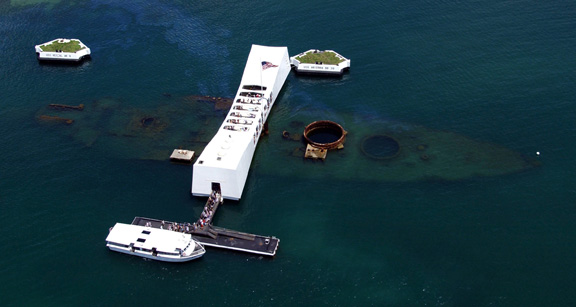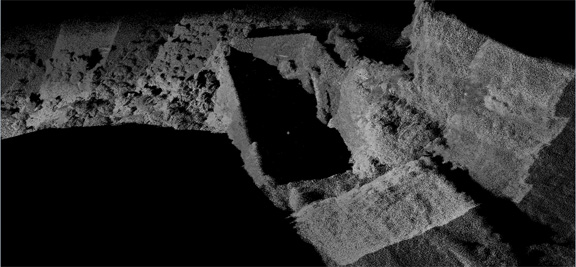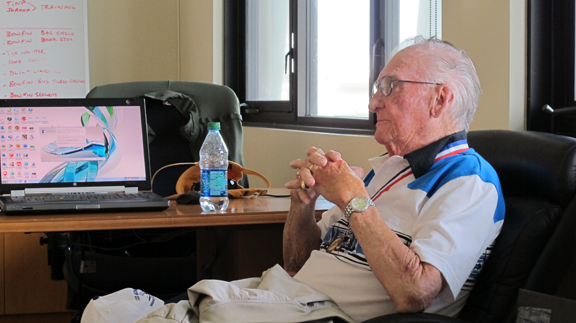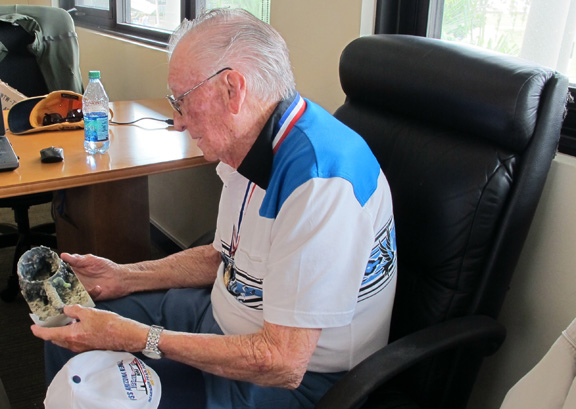May 30, 2014
On December 7, 1941, when Japanese fighter planes flew into Pearl Harbor, Don Stratton was a 19-year-old Navy seaman on the deck of USS Arizona, where nearly half of the casualties from the attack occurred. He survived what he called “an awful horrendous day,” with burns throughout 70% of his body. The wreckage of the battleship still rests underwater today, but this May, Stratton, now 92, was literally touched by a piece of history. He held in his hand a 3D-printed model of the barnacle-encrusted cooking pot from the ship’s deck, reproduced from the scan data acquired by underwater divers.
The 3D model and the scan are part of the National Park Service’s project for the USS Arizona Memorial Park, complete with digital 3D models that the public would be able to explore. One of the project team members, Autodesk’s strategic projects executive Pete Kelsey, was moved by his meeting with Stratton. “I got to hand him a 3D-printed model of the scan. With tears in his eyes, [Stratton] asked me to thank the entire project team,” recalled Kelsey. “What was amazing to me was, without much explanation from us about the technology, he immediately understood that, long after he’s gone, the memories of his fallen shipmates and friends would live on in these digital and analog (3D-printed physical) models.”
This past Memorial Day, Autodesk and the National Park Service held a press conference. “At today’s press conference, a 3D printout of the USS Arizona showcased details never seen before on paper,” according to the press release. “In addition, highly detailed 3D models of a cooking pot and Coke bottle that have sat on the ship’s galley for the past 72 years were also created and displayed. Each model featured intricate details including color and the barnacles now present on the cooking pot. Autodesk and NPS hope to create a 3D model of the USS Arizona in its entirety by the end of this year.”
The LIDAR, sonar, and photogrammetry data captured by underwater divers equipped with scanners and cameras is compiled into a cohesive 3D model in Autodesk ReCap software. The team is also using Infraworks, a program developed for civil engineering, to create impressive visuals based on the captured data. Subsequently, the team plans to use Project Memento, a technology preview from Autodesk Labs, to transform raw point-cloud data into editable 3D mesh models.
“The National Park Service is interested in the raw point-cloud data for digital archival,” remarked Kelsey. “This is the first time anyone has done a comprehensive survey scan of the site. No one really understood what changes were happening underwater. So everyone was keen on studying it—taking measurements, detecting the changes over time, and so on. They’re also interested in using the data to create a virtual experience for education, communication, and outreach to the public.”
All team members in the project volunteered and their time, expertise, and technology for free to help preserve the USS Arizona.
The survey project team from 2013 involves:
- National Park Service (Owner)
- HDR (Project Manager)
- Autodesk (Underwater Photogrammetry, Autodesk ReCap & Autodesk Infraworks)
- Sam Hirota, Inc. (Land Surveying, Terrestrial Laser Scanning)
- Oceanic Imaging Consultants, Inc. (Multibeam Sidescan SONAR)
- 3DatDepth (Subsea LiDAR)
- Shark Marine Technologies, Inc. (Diver Portable SONAR)
- U.S. Coast Guard (Flight Support)
- U.S. Navy Mobile Diving Salvage Unit One (Dive Support)
For more, watch the video report below (video footage courtesy of Autodesk):
Subscribe to our FREE magazine, FREE email newsletters or both!
About the Author
Kenneth Wong is Digital Engineering’s resident blogger and senior editor. Email him at [email protected] or share your thoughts on this article at digitaleng.news/facebook.
Follow DE









